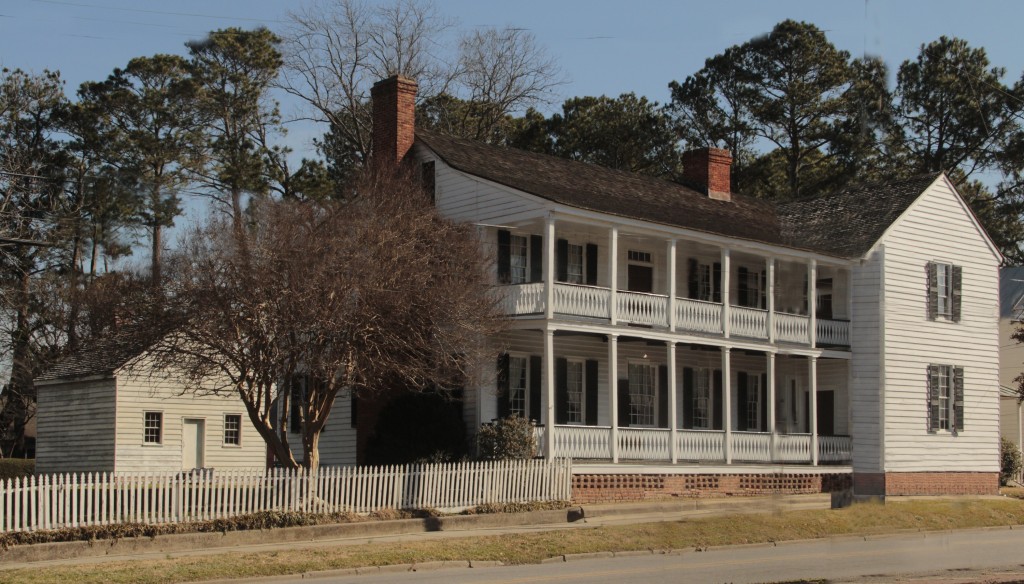U. S. National Registry of Historic Place

James Iredell House – photo William Ahearn
The home of James Iredell, Sr. (1751-1799) was built in 1773 and was most recently enlarged in 1810, over 200 years ago. Iredell was the youngest (38) appointee in 1790 when President George Washington named him as a Justice on the first United States Supreme Court. He was confirmed by the U. S. Senate the following day.
Years later, his son, James Iredell, Jr. also resided in the house and became Governor of North Carolina.
The dwelling was erected 1773 by Joseph Whedbee and consisted of the two-story gable front section on the east.

Library in Iredell House – photo Kip Shaw
The interior was architecturally side-hall in plan. James Iredell, Sr. bought the house in 1778. During the early nineteenth century (1810), lredell’s widow Hannah Johnston Iredell enlarged the house to the present two-story center-hall floor plan. Covered with beaded weatherboards, the one-bay building had a single exterior chimney. The interior side-hall plan house may have been an expansion of Wilkins’ circa 1756 house, thus explaining the gable’s atypical orientation to the street.
James Iredell came to Edenton as the Deputy Collector for the North Carolina Port of Roanoke at age 17, studied law under Samuel Johnston (a future Governor and U. S. Senator of North Carolina) and married his mentor’s sister, Hannah. He was very active in political matters and was Attorney General of North Carolina by age 28. Iredell died in 1799 and his wife died in 1826. The house remained in the Iredell family until 1870, then was sold to the McCoy Family. In 1949 the property was sold to the Edenton Tea Party Chapter of the Daughters of the American Revolution.
During the early nineteenth century, Iredell’s widow added the two-story center-hall plan block on the west. The house remained in Mrs. Iredell’s possession until her death in 1826, and in her daughter’s estate until 1870. Saved in 1948 by the Edenton Tea Party Chapter, National Society Daughters of the American Revolution, the house is owned and managed by the State of North Carolina. The James Iredell Association assisted in restoring and furnishing the building. The circa 1829 Bandon Plantation office, now furnished as a school, was moved in 1964 in appreciation of novelist Inglis Fletcher, who wrote part of the Carolina series here. Although the Bandon Plantation house was destroyed by fire in 1964, the kitchen was deconstructed and moved here in 2009. Reconstruction was completed in 2013.
Edenton Tea Party Chapter DAR history:
The Edenton Tea Party Chapter DAR was chartered on February 27, 1948 and their first act of business was to acquire and restore the home of James Iredell. These 20 women signed bank notes to make this acquisition a reality and to allow preservation of this residence. In 1951 the house was turned over to the State of North Carolina Cultural Resources and today the house and Edenton Visitor Center are all part of the Edenton Visitor Site. The house has been completely furnished by the James Iredell Association.
You asked for a funny story!!!!!
These 20 ladies are often compared to the 51 Tea Party Ladies. They went to the Banker told him their business and signed the bank notes to purchase the house. The next morning there were 20 husbands at the bank wanting to know why this banker had let these 20 ladies sign bank notes. The banker’s wife was one of these ladies. There were almost 20 divorces. But the Edenton Tea Party saved the house and it is an architectural gem that Edenton is proud of today.
There is a DAR marker on the lawn of the James Iredell House in recognition of the Charter member’s effort in 1948 to save the house.
Visit and learn more about other sites on the Edenton Museum Trail:
(1) Barker House
(2) Old Colonial Wharf
(3) Joseph Hewes & 1778 Cannons
(4) Hugh Williamson Monument
(5) 1905 Edenton Teapot


